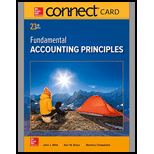
Concept Introduction:
Net Sales: Sales are the revenues earned by the company from its major operation. It is arrived after deducting sales returns if made by the customers from its gross sales.
Gross Profit: Gross Profit is the profit that is earned by the company after deducting cost of making the product from its sales.
Gross margin ratio: It is arrived by dividing the net sales from the gross profit and predicts the margin on net sales in percentage.
To Determine: The net sales, gross profit and the gross profit margin ratio and interpret the gross margin ratio results in case a.
Explanation of Solution
| S. No. | Net sales | Gross profit | Gross profit margin ratio |
| a | |||
| b | |||
| c | |||
| d |
Interpretation of gross margin ratio of case a:
Gross margin ratio depicts how much earning is left over with the company after meeting the cost of goods sold. A higher ratio depicts the efficiency of the company in terms of its production cost. In case a, the company’s gross margin ratio is 36.20%. It shows that the company’s cost of goods sold in terms of sales percentage is 63.80%.
Want to see more full solutions like this?
Chapter 5 Solutions
Connect Access Card for Fundamental Accounting Principles
- Please explain the solution to this general accounting problem with accurate principles.arrow_forwardI am searching for the correct answer to this general accounting problem with proper accounting rules.arrow_forwardi will give unhelpful.blurr image please comment i will write values. please dont Solve with incorrect values otherwise unhelpful.arrow_forward
- Please provide the accurate answer to this general accounting problem using valid techniques.arrow_forwardCompute the total cost of the Graphico order.arrow_forwardCobalt Corporation applies overhead based on direct labor cost. Estimated overhead and direct labor costs for the year were $98,200 and $112,000, respectively. During the year, actual overhead was $94,300, and actual direct labor cost was $108,000. The entry to close the over- or underapplied overhead at year-end, assuming an immaterial amount, would include: A. a debit to Cost of Goods Sold for $300.40 B. a credit to Cost of Goods Sold for $ $394.40 C. a credit to Finished Goods Inventory for 398.80 D. a debit to Work in Process Inventory for 410.00 E. a credit to Factory Overhead for $361.75arrow_forward

 AccountingAccountingISBN:9781337272094Author:WARREN, Carl S., Reeve, James M., Duchac, Jonathan E.Publisher:Cengage Learning,
AccountingAccountingISBN:9781337272094Author:WARREN, Carl S., Reeve, James M., Duchac, Jonathan E.Publisher:Cengage Learning, Accounting Information SystemsAccountingISBN:9781337619202Author:Hall, James A.Publisher:Cengage Learning,
Accounting Information SystemsAccountingISBN:9781337619202Author:Hall, James A.Publisher:Cengage Learning, Horngren's Cost Accounting: A Managerial Emphasis...AccountingISBN:9780134475585Author:Srikant M. Datar, Madhav V. RajanPublisher:PEARSON
Horngren's Cost Accounting: A Managerial Emphasis...AccountingISBN:9780134475585Author:Srikant M. Datar, Madhav V. RajanPublisher:PEARSON Intermediate AccountingAccountingISBN:9781259722660Author:J. David Spiceland, Mark W. Nelson, Wayne M ThomasPublisher:McGraw-Hill Education
Intermediate AccountingAccountingISBN:9781259722660Author:J. David Spiceland, Mark W. Nelson, Wayne M ThomasPublisher:McGraw-Hill Education Financial and Managerial AccountingAccountingISBN:9781259726705Author:John J Wild, Ken W. Shaw, Barbara Chiappetta Fundamental Accounting PrinciplesPublisher:McGraw-Hill Education
Financial and Managerial AccountingAccountingISBN:9781259726705Author:John J Wild, Ken W. Shaw, Barbara Chiappetta Fundamental Accounting PrinciplesPublisher:McGraw-Hill Education





